

Priorities.
Monday, January 31st, 2011 | Posted by JW Randolph | No Comments
AP Reporter Wins Peeew-litzer for Execrable Reporting on Stream Protection Rule
Thursday, January 27th, 2011 | Posted by Matt Wasson | No Comments
[UPDATE: With the benefit of a little more time to reflect and with the help of a few angels on my shoulder, I’ve come to realize that my criticism of Tim Huber was over the top. While I believe that my critique of the content of the AP story was valid, there are more respectful and less polemical ways to make the point. My apologies to Tim Huber]
 OK, so I made the bit up about there being a Peeew-litzer prize for execrable reporting, but if there were such a prize, AP business reporter Tim Huber would be a top candidate.
OK, so I made the bit up about there being a Peeew-litzer prize for execrable reporting, but if there were such a prize, AP business reporter Tim Huber would be a top candidate.
Yesterday, Huber broke a story based on a leaked draft of an environmental impact statement that is part of the Office of Surface Mining’s rule-making process for the “Stream Protection Rule.” This rule would replace the “Stream Buffer Zone” rule that was gutted in late 2008 in an 11th hour giveaway to the coal industry by the departing Bush Administration. The impact and clear intent of Bush’s change to this rule was to make it easier for coal companies to conduct mountaintop removal mining operations in Appalachia.
The lead of the AP story went as follows:
The Obama administration’s own experts estimate their proposal for protecting streams from coal mining would eliminate thousands of jobs and slash production across much of the country, according to a government document obtained by The Associated Press.
Wow, that sounds pretty bad — particularly the day after the President delivered a State of the Union address that laid out a broad plan for creating jobs and supporting American businesses. Of course, given that the leaked document is not available for public scrutiny, you might think that Huber would say a little something about what assumptions went into this calculation of job losses — perhaps even provide a little context about how they were calculated. What baseline assumptions were these “eliminated” jobs compared to? Did the agency use figures for say, 2008 when coal production was at an all time high, or did they compare their impacts to government estimates of future production? This is important because not only has coal production dropped by 10% since 2008, but recent EIA projections are that coal production will drop further in coming years and won’t return to 2008 levels until 2025.
Aside from “eliminating” jobs in the coal industry, would OSM’s rule perhaps also create jobs in other industries that would presumably replace demand for the “slashed” coal production? Was the economic analysis done by OSM mining experts, or did they work with the Energy Information Administration, which has models to address these sorts of questions in the context of overall US energy markets?
Without additional context, there’s no way to understand what these numbers actually mean. By putting them out there in sensationalist terms without any way for anyone else to see the context and assumptions that went into them, Huber has done an enormous disservice to entire debate about protecting streams from the impacts of coal mining. And while reporting on leaked documents has a long and proud tradition, isn’t there some obligation to provide essential information needed to understand what’s reported about them?
Of course, it seems that there were people outside federal and state agencies that already had their hands on the secret draft document because Huber provided a quote from the National Mining Association that could only have been made if they had already analyzed the numbers (wonder who leaked it to Huber?). Worse, Huber reported the NMA’s response without even contacting any supporters of a strong Stream Protection Rule to see if there might be different views on those numbers.
So how would mountaintop removal opponents have responded if they’d had the chance?
I imagine if Huber had asked people impacted by mountaintop removal mines above their homes they would have said that there is no economic justification whatsoever for the continued destruction of Appalachian mountains, streams and communities by coal companies. As my friend Bo Webb at Coal River Mountain Watch told the Charlotte Observer when asked about Duke Energy’s machinations over whether eliminating mountaintop removal coal purchases would be economical:
“Real people that live in communities beneath mountaintop removal sites in southern West Virginia are paying the heavy, hidden costs of coal with their health and lives. An energy company that purchases mountaintop-removal coal is taking advantage of a corrupt regulatory system that allows coal companies like Massey Energy to eliminate entire Appalachian mountains, poison its water and kill its people.”
If Huber had asked my buddy JW at Appalachian Voices he might have pointed out that the coal industry is already in decline, particularly in Appalachia. If jobs are going to be eliminated anyway, why would we want to preserve jobs at mines that destroy streams over jobs that don’t? When I asked him about it, JW, who’s about to have his first child, told me:
“When my daughter enters the workforce, she can either have A) no coal jobs and no streams or B) no coal jobs and streams. We’ll take B please.”
And if I’d been asked? Well, since Huber isn’t prepared to share the leaked document he’s reporting on, it’s tough to get too specific. But even in the unlikely case that OSM did a comprehensive economic study and found that 7,000 jobs really would just vanish off the employment map, let’s put that number in perspective. If those surface mining jobs were eliminated over a 5 year period as existing permits expire, the challenge for legislators like Senator Manchin would be to find a way to create an additional 1,400 non-mining jobs or so per year (perhaps more, as mining jobs pay well) in order to rein in the wholesale destruction of streams in Appalachia by mountaintop removal mining and the pollution of streams across the country with mine waste.
And it’s not like it takes a lot of creative thinking to figure out how those jobs could be replaced: the Appalachian Regional Commission released a study and blueprint for how 15,000 jobs per year could be created in Appalachia every year for the next five years in energy efficiency — if policy-makers would make fairly modest investments in policies to stimulate the creation of those jobs. As a West Virginian who commented on the story at the Charleston Gazette website pointed out,
“It’s called ‘progress.’ We don’t use whale oil for light anymore do we?”
No we don’t. And I bet lot of jobs were lost in the whaling industry after Edison invented the light bulb along with coal-based electricity generation technologies… was that bad for society over the past century?
I recently heard a pretty smart guy say:
“Sustaining the American Dream has never been about standing pat. It has required each generation to sacrifice, and struggle, and meet the demands of a new age… So instead of subsidizing yesterday’s energy, let’s invest in tomorrow’s.”
We should listen to him.
Why Fight When You Can Hide?
Wednesday, January 26th, 2011 | Posted by Eric Chance | 3 Comments
Welcome to the biggest fight of 2011! In one corner, Appalachian Voices’ Water Watch team stands poised and ready to fight for clean water. In the other corner, Big Coal tries to defend their polluting ways. The next round of the showdown will begin on Thursday, January 27 at 1:30 pm in a Kentucky courtroom. Who will come out on top?
Read on to get the pre-match rundown. (more…)
Read More ...President Obama’s SOTU and Coal
Wednesday, January 26th, 2011 | Posted by JW Randolph | No Comments
 Many folks have asked what we thought of President Obama’s speech this evening. In particular, this section:
Many folks have asked what we thought of President Obama’s speech this evening. In particular, this section:
Now, clean energy breakthroughs will only translate into clean energy jobs if businesses know there will be a market for what they’re selling. So tonight, I challenge you to join me in setting a new goal: by 2035, 80% of America’s electricity will come from clean energy sources. Some folks want wind and solar. Others want nuclear, clean coal, and natural gas. To meet this goal, we will need them all — and I urge Democrats and Republicans to work together to make it happen.
(The White House also released greater detail about their “clean energy plans.”)
1) Appalachian Voices aggressively supports efforts at the state and federal level that will help provide economic diversification in Appalachia, particularly economic development with a clean energy focus. This includes support for projects as diverse as the Coal River Mountain Wind Project and the bipartisan “Rural Star” energy efficiency legislation which passed the House last year. We will always continue to push for legislation that provides jobs, economic diversification, and a clean energy future for our country and our region.
2) As the President said the words “…by 2035…” one thing that struck me was that I don’t think anybody believes that there will be much of a Central Appalachian coal economy left in the year 2035. Much of the once dominant coal industry has already left the region, and industry analysts and their allies in Congress are saying that there just isn’t much of a future left in Central Appalachian coal. I guess Joe Manchin plans to be out of office by then? Sadly, many thousands more coal miners that Manchin and Joe Rahall purport to speak for will also be out of work long before then.
3) Mountaintop removal coal has never been and never will be a “clean energy source.” It doesn’t matter what you think about carbon sequestration, climate change, or emissions limits. As long as we are mining coal by mountaintop removal, it is dirty (and deadly) LONG before it gets to the power plant.
My two cents. Other reactions from Joe Romm’s Climate Progress, Friends Of the Earth, AWEA, GetEnergySmart!Now!, Michael Levi, and a good roundup from The Hill.
What’d you think of the speech?
(more…)
Maddow Show Talks Manchin, EPA, Mountaintop Removal
Monday, January 24th, 2011 | Posted by JW Randolph | No Comments
Great Segment, but NYT Reporter Matthew Wald Gets a Few Things Wrong
The Rachel Maddow show has been great about covering some of the media circus the coal industry has caused in Appalachia ove the last few years. From the singing lumps of coal, to the stock-photo-FACES-of-coal scandal, to their top-notch coverage of the Upper Big Branch Mine disaster, they have been one of the leading news programs covering the devastating and deceitful practices of the coal industry in our mountains. In fact, this segment on the media-magnet-for-all-the-wrong-reasons that is Joe Manchin aired over the weekend, continuing some of the discussion (and even using some of the graphs) from our blog last week about mountaintop removal causing job loss.
Visit msnbc.com for breaking news, world news, and news about the economy
Hat-tip to Jeff Biggers
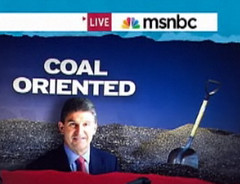 Substitute anchor Chris Hayes rightly points out that Joe Manchin has been making all the right mistakes to really earn his George Bush-like swagger. That much we expected. In fact, West Virginia resident Bob Kincaid told us:
Substitute anchor Chris Hayes rightly points out that Joe Manchin has been making all the right mistakes to really earn his George Bush-like swagger. That much we expected. In fact, West Virginia resident Bob Kincaid told us:
This may just be my bias, but I honestly think Joe looks more silly and out-of-place in the Senate than Bush did in the White House. Believe me when I say I NEVER thought I’d say anything like that.
However,it was surprising to hear Hayes’ guest, New York Times energy reporter Matt Wald, suggest that the impacts of mountaintop removal on Appalachian citizens, mountains, and communities is “not very unusual” in the typical dynamic between the energy sector and the citizens who live where they produce energy. Wald also went out of his way to wrongly assert that what EPA did was “not a veto” (it certainly was), but in fact “they reversed themselves.” They did no such thing. As readers of this blog will know, while the Army Corps of Engineers did approve the permit, EPA never gave final sign off to the Spruce Mine permit, expressed concerns from the very beginning, and then vetoed the permit. Thats what it was. A veto.
Mr. Wald would be wise to have read his own newspaper’s editorial last week on this same subject.
From the NYT’s “A Clear No on Spruce“:
The Spruce No. 1 Mine, owned by Arch Coal, would have required dynamiting the tops off mountains over an area of 2,278 acres to reach subsurface coal seams. The resulting rubble, known as spoil, would then be dumped into the valleys and streams below — ruining, by the E.P.A.’s estimate, six miles of high-quality streams and causing “unacceptable” damage to the environment.
Thousands of miles of streams in Appalachia have already been poisoned in this manner in clear violation of the Clean Water Act.
Mr. Wald, we do not believe that mountaintop removal is not business as usual. We cordially invite you to come and visit Appalachia with us, do a flyover, and decide for yourself if the obliteration of more than 1.2 million acres, 500 mountains, 2000+ miles of streams, dozens of communities, 10s of 1000s of traditional mining jobs lost is “business as usual.”
Impacts of Coal 101: Mountaintop Removal = Job Removal
Friday, January 21st, 2011 | Posted by JW Randolph | 4 Comments
Or, How I Started Worrying when I Learned that Joe Manchin Doesn’t Know What he is Talking About
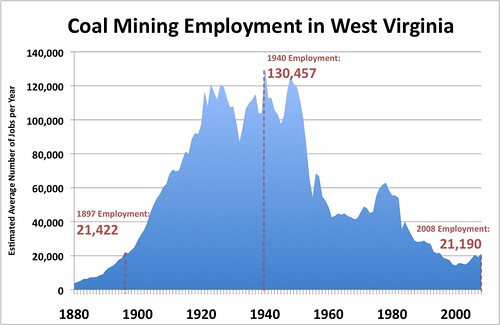 We will start today’s post with a simple hypothesis. Mountaintop removal means FEWER mining jobs for Appalachia. We will go into the correlation with poverty, the horrific physical health problems, the desperate need for economic diversification in the region, the permanent aquatic impacts, the other opportunities Appalachian Voices’ and others are fighting for, and how Appalachian coal is in permanent decline. But for now, lets review why mountaintop removal has been a decades long NIGHTMARE for fans of job creation in Central Appalachia.
We will start today’s post with a simple hypothesis. Mountaintop removal means FEWER mining jobs for Appalachia. We will go into the correlation with poverty, the horrific physical health problems, the desperate need for economic diversification in the region, the permanent aquatic impacts, the other opportunities Appalachian Voices’ and others are fighting for, and how Appalachian coal is in permanent decline. But for now, lets review why mountaintop removal has been a decades long NIGHTMARE for fans of job creation in Central Appalachia.
Mountaintop removal mining is designed specifically to remove the miner from the process, replacing manpower with machinery, and lowering the coal companies’ overhead cost. Coal mining employs fewer people today than it did at the turn of the 19th century. West Virginia, which once employed over 130,000 coal miners, now has a coal mining workforce of about 20,000 miners. Declining coal production and productivity in central Appalachia ensures that this downward trend will continue.
Reportedly 1,000 people showed up at a taxpayer funded rally to ignore the impacts of mountaintop removal at the state capitol in Charleston, WV yesterday. The real story is that those participants are less than 1% of the 10s of 1000s of miners whose jobs have been destroyed by the coal industry in the last few years. Now, we know that the coal industry is hell-bent on continuing to destroy the traditional coal jobs our region has depended on (not to mention the mountains, streams, and public health), but I want these folks who support a completely unregulated coal industry to understand that mountaintop removal causes unemployment.
But don’t take my word for it!
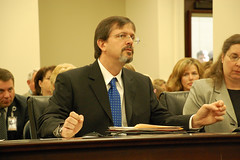 “Areas with especially heavy mining have the highest unemployment rates in the region; contrary to the common perception that mining contributes to overall employment.”
“Areas with especially heavy mining have the highest unemployment rates in the region; contrary to the common perception that mining contributes to overall employment.”
– Dr. Michael Hendryx, Mortality in Appalachian Coal Regions
“History shows that the transition from deep to surface mining devastated the region economically, and that the prosperity of mining companies has not gone hand in hand with the economic welfare of coal mine workers….Central Appalachia has suffered from current and persistent economic distress, and that this distress “has been associated with employment in the mining industry, particularly coal mining.
– Synapse Energy Economics, Economic Impacts of Restricting Mountaintop/Valley Fill Coal Mining in Central Appalachia
 The increased use of mountaintop removal mining means that fewer miners are needed to meet company production goals. Meanwhile the Central Appalachian coal seams that remain to be mined are becoming thinner and more costly to mine. Mountaintop removal mining, a declining national demand for energy, rising mining costs and erratic spot market prices all add up to fewer jobs in the coal fields.
The increased use of mountaintop removal mining means that fewer miners are needed to meet company production goals. Meanwhile the Central Appalachian coal seams that remain to be mined are becoming thinner and more costly to mine. Mountaintop removal mining, a declining national demand for energy, rising mining costs and erratic spot market prices all add up to fewer jobs in the coal fields.
– Senator Robert C. Byrd, 12-03-09
 The state’s most productive coal seams likely will be exhausted in 20 years. And while coal will remain an important part of the economy, the state should emphasize green job development. That is especially important as pressure against mountaintop mining increases. Pressure is coming from both Republicans and Democrats. During the 2008 presidential race, Republican nominee John McCain came out in favor of ending mountaintop mining. It’s something that’s evolving over time in our industry and the responsible segment of our industry realizes that
The state’s most productive coal seams likely will be exhausted in 20 years. And while coal will remain an important part of the economy, the state should emphasize green job development. That is especially important as pressure against mountaintop mining increases. Pressure is coming from both Republicans and Democrats. During the 2008 presidential race, Republican nominee John McCain came out in favor of ending mountaintop mining. It’s something that’s evolving over time in our industry and the responsible segment of our industry realizes that
– Congressman Nick Rahall (D-WV-03), 04-02-09
Mountaintop removal not only whittles away underground mining jobs, it also creates enormous barriers to economic development and diversification, by making the area less attractive for other industries, due to the pollution of the land, air and water. Coal mining communities in Appalachia shower higher rates of economic distress in proportion to the amount of mining that occurs there and significantly more than in non-coal mining communities.
There is popular bipartisan legislation, the Clean Water Protection Act (House) and Appalachia Restoration Act (Senate), which would end the devastating practice of valleyfills. No industry should be able to dump their toxic waste into streams, and the coal industry doesn’t deserve a special carve out that allows them to poison local communities. The 2003 EPA Environmental Impact Statement shows that stopping valley fills would have a less than 1% impact on electric rates. The cost savings of mountaintop removal coal on consumers is, at best, negligible. In fact, new data shows North Carolina (and other states) paid more for strip-mined coal than for underground-mined coal in 2008. It was actually MORE expensive to use mountaintop removal coal, by every single measure imaginable.
Even the coal industry’s biggest supporters recognize Central Appalachian coal production is in permanent decline. Production has dropped 20% since 2008, and the EIA expects another 50% drop in Central Appalachian production by 2015. Job-killing strip-mining will play an increasingly large part in that increasingly small number. What part of that do Joe Manchin, Nick Rahall, and Earl Tomblin not see? Probably the part that keeps coal money rolling into their campaign coffers. The tragic part is that it keeps the rest of Appalachia like this.
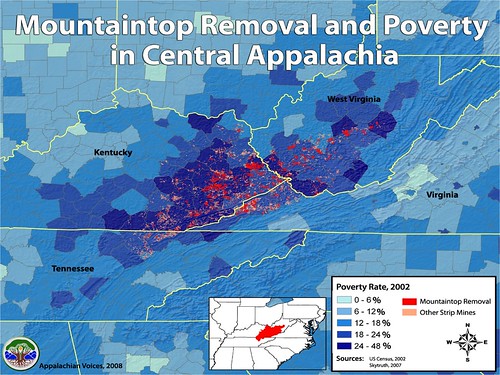
And next week, we’ll go into why mountaintop removal is a public health catastrophe, leaving Appalachia like this…
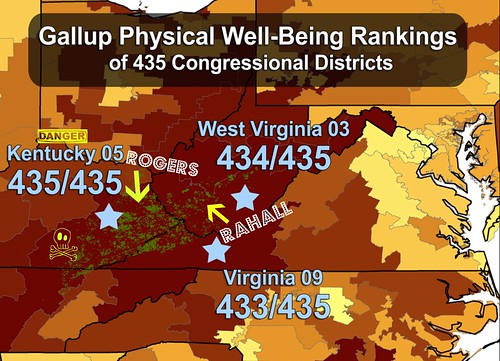
EPA Vetoes Massive Mountaintop Removal Mine — Now Buckle Up for the Backlash
Wednesday, January 19th, 2011 | Posted by Matt Wasson | 2 Comments
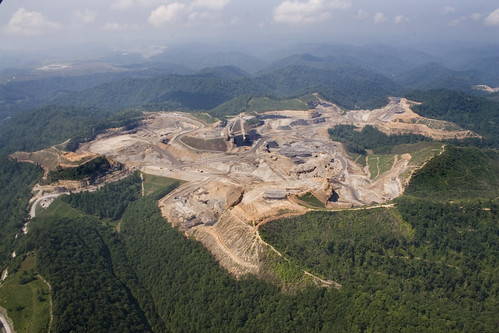 In the wake of EPA’s veto last week of the largest mountaintop removal mine permit ever proposed in West Virginia, the grandstanding of West Virginia politicians and “sky is falling” rhetoric from the coal industry was not surprising. Every effort to protect streams and communities from the devastating impacts of mountaintop removal has been met with a similar chorus of complaint by coal companies and local politicians.
In the wake of EPA’s veto last week of the largest mountaintop removal mine permit ever proposed in West Virginia, the grandstanding of West Virginia politicians and “sky is falling” rhetoric from the coal industry was not surprising. Every effort to protect streams and communities from the devastating impacts of mountaintop removal has been met with a similar chorus of complaint by coal companies and local politicians.
However, the immediate response of coal industry groups and West Virginia politicians to the news of EPA’s action was a little different this time around. Notably absent was any reference to the so-called “War on Coal,” which had previously been a mainstay of the coal industry’s talking points. Instead, every West Virginia politician and coal industry trade group that issued a response to EPA’s action appeared to be reading from the same script – a new one focused on broad national implications of EPA’s action for all US industries, not just coal. Apparently we are now to believe that the opposition of West Virginia politicians to any and all regulations protecting streams from obliteration by coal companies is not about any provincial concerns or pressure from the most powerful industry in their district, but about “regulatory certainty,” national energy supply, national security and the unemployment rate.
The new narrative about overbearing federal regulators stifling the economy and threatening national security fits nicely with the ideological persuasions of many new members of Congress. They would seem to be the primary target of the coal industry’s new PR strategy, the goal of which is clearly to convince Congress to rein in the EPA and prevent the agency from promulgating new rules or enforcing existing ones. And the centerpiece of this new narrative is EPA’s veto of the Spruce permit, which, it is increasingly apparent, was part of the coal industry’s game plan all along.
Read More ...



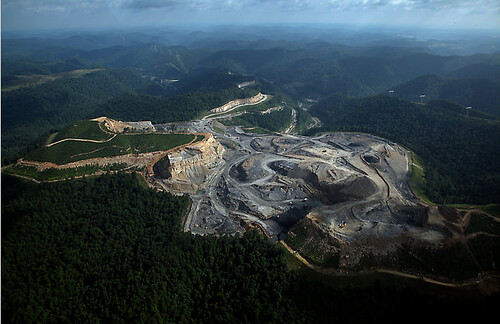 Which leads me to wonder…has anyone ever been so loud and proud about shoving their head in the sand and ignoring
Which leads me to wonder…has anyone ever been so loud and proud about shoving their head in the sand and ignoring  First of all, if you do your research (as Ken Ward does) you know that
First of all, if you do your research (as Ken Ward does) you know that

